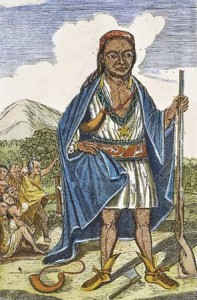Metacom or King Phillip – Charismatic Leader

Metacom, called “King Phillip,” by the English became sachem of the Plymouth area tribe in 1662.
Metacom, or King Phillip as he was known by the English, was chief of the Wampanoag in southeastern Massachusetts. Apparently a charismatic personality, Metacom was able to leverage seething resentments.
The spark that set off the war was Metacom’s contention that the English had murdered his brother. The underlying causes were the Indian’s fear of the never ending pressure to sell their land (a concept which was more English than Indian anyway) and increased dependence on trade goods from the new comers.
Native Americans Being Crowded Out by the 1660’s
At the time (1675) of the war, the colonists were, in fact, starting to overwhelm the Indian population:
- there were 20,000 settlers along the coast and Connecticut River and, growing at 3% a year, the population was doubling every 25 years–even without new immigration
- they were spread out over 110 towns in New England (60% in Massachusetts)
- meanwhile the Indian population in New England as a whole had declined to about 10,000.
The flintlocks, steel knives, copper pots and other trade goods (colonists were forbidden to sell liquor or guns to the Indians but somehow it happened) were requiring more and more deerskin and beaver skins — which were becoming harder and harder to find.
Bloodiest War Ever Fought on Massachusetts Soil
The result was a devastating war that set back settlement of Western Massachusetts and left permanent scars on some of the families that eventually settled Lenox

-600 Colonial lives were lost, 12 towns were totally destroyed, and more were damaged
-over 3,000 Indians died (many from disease); those who were not enslaved merged with other tribes to the west (but not the Mohawks who were and remained traditional enemies)
-the war (paid for by the Colonials) cost 100,000 pounds – a huge sum at a time when most families earned less than 20 pounds/ year.
Metacom and his allies (the Mahicans remained allied with the English) raided up and down the Massachusetts part of the Connecticut River Valley and the towns too small to defend themselves were abandoned. About 600 colonists died, but the impact of the war on the Indians was catastrophic. The already diminished Indian population was – by some estimates – reduced by 60-80%; 2,000 killed, 3,000 felled by disease, 1,000 sold into slavery, 2,000 fled north or west (although not too far west – these largely Algonquin tribes were long time enemies of the Iroquois in New York).
Destruction included leveling most of the nascent community of Springfield and ambushes around Deerfield that led to its temporary abandonment. Jonathan Hinsdale’s grandfather was among those killed in the Battle of Bloody Brook while trying to deliver a grain harvest from Deerfield to Hadley.
Native Americans Would Fight Again – But Largely at the Behest of Europeans Fighting Each Other
Although European entities (French and Indian Wars) would continue to try to leverage Indian alliances for European wars in the new world, the Indian era in Massachusetts was for all intents and purposes over . Hopes of trust and integration between the Colonials were largely at an end (with some important future exceptions such as the Stockbridge Indians.)
Consequences for the Colonials included:
-fear of being in small, isolated communities (such as Deerfield) which would last through much of the 85 years of French and Indian wars
-reluctance to expand to the unsettled western part of the state
-increased sense of independence – the newly restored Charles the II had no sympathy for the Puritans who had deposed and executed his father so the Colonials were limited to their own manpower and resources to respond to the threat from King Phillip.
See:
Wikipedia “King Phillip’s War,” 2015
“Early Settlers of Hartford – Issac Hinsdale, Barnabas Hinsdale” – Ancestry
The History Place – King Philip’s War in New England – America’s First Major Indian War,” by Michael Tougias
